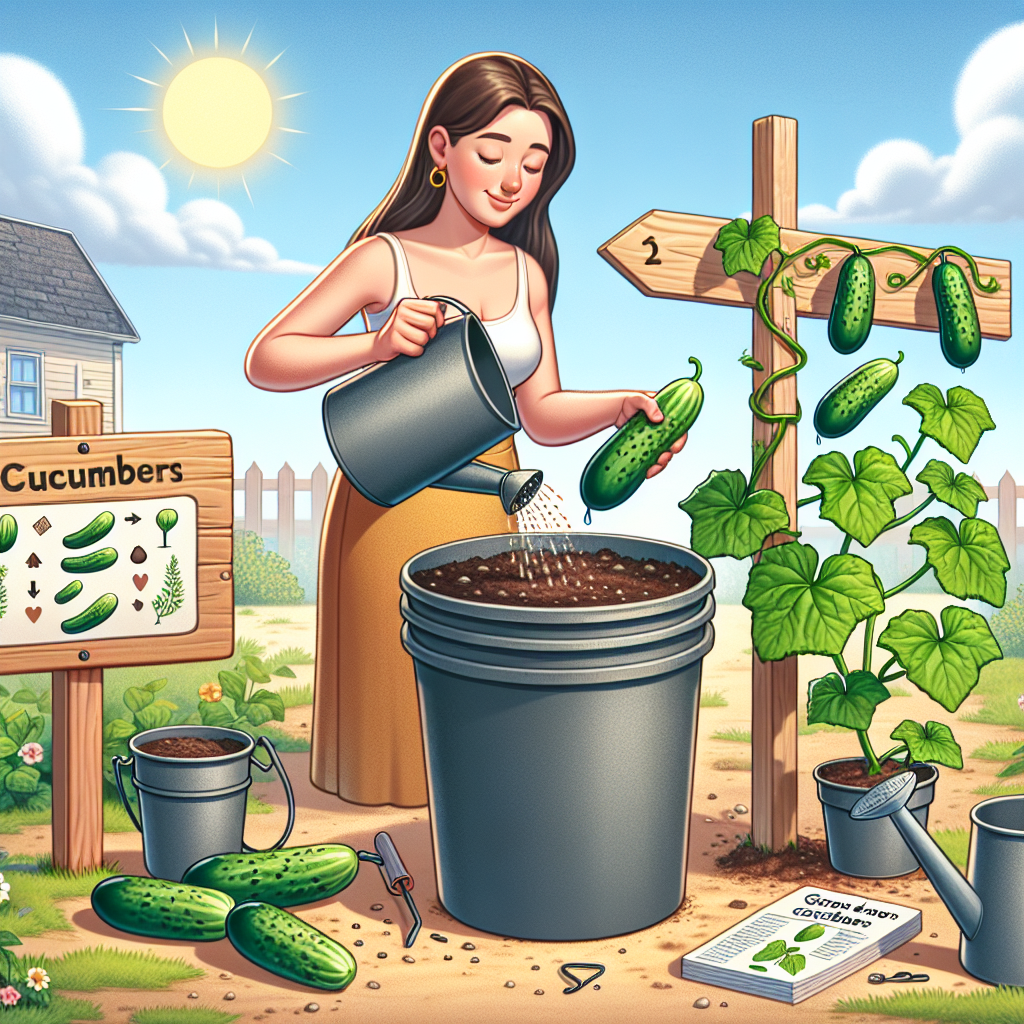
How to grow cucumbers in a 5 gallon bucket
How to Grow Cucumbers in a 5 Gallon Bucket: A Comprehensive Guide
Cucumbers are a delightful garden vegetable, perfect for fresh salads, pickles, and a variety of dishes. If you're short on garden space or want to enjoy gardening in a more controlled environment, using a 5-gallon bucket can be an excellent solution. In this guide, we’ll explore how to grow cucumbers in a 5-gallon bucket, covering everything from choosing the right variety to watering techniques. Whether you're a seasoned gardener or a beginner, this method can provide you with great results!
Choosing the Right Cucumber Variety
The first step in successfully growing cucumbers in a 5-gallon bucket is selecting the right variety. Cucumbers fall into three main categories: slicing, pickling, and burpless. Each type has its unique qualities, so here’s a closer look.
- Slicing Cucumbers: These are typically long and can be eaten fresh. Popular varieties include 'Straight Eight' and 'Marketmore 76.'
- Pickling Cucumbers: Smaller and often bumpier, these cucumbers are ideal for pickling. Consider varieties like 'Persian' or 'Picklebush.'
- Burpless Cucumbers: These are known for their mild flavor and reduced bitterness, making them easier to digest. Variants like 'Sweet Success' are great choices.
Preparing Your 5 Gallon Bucket
To successfully grow cucumbers, you need to prepare your 5-gallon bucket properly. Follow these steps:
Choosing the Right Bucket
Make sure your bucket is food-safe and has not been previously used to store harmful chemicals. Check for a recycling symbol with a '1' or '2' to ensure it's safe.
Drilling Drainage Holes
Drainage is crucial for cucumber health. Use a drill or a sharp knife to make several holes at the bottom of the bucket. This will prevent water from pooling and causing root rot.
Adding Soil
Use a high-quality potting mix that provides good drainage and nutrients. A mixture of peat moss, vermiculite, and compost works well. Fill the bucket to about 2 inches from the top to allow for watering.
Planting Your Cucumbers
Once your bucket is ready, it's time to plant your cucumber seeds or seedlings. Here’s how you can go about it:
Seed Selection and Preparation
If you’re planting seeds, soak them in water for 8-12 hours before planting. This will improve germination rates. If you're using seedlings, ensure they are healthy and ready for transplanting.
Planting Depth and Spacing
For seeds, plant them about 1 inch deep. If using seedlings, make a hole large enough for the root ball and place the seedling gently in the soil.
Spacing Considerations
Since cucumbers can be vigorous climbers, you can plant 2-3 seeds or seedlings in one bucket. For bush varieties, stick to 2 plants, whereas vining types can accommodate 3 for better yields.
Watering Your Cucumbers
Proper watering is essential as it helps the cucumbers develop in a bucket. Here are some guidelines:
Watering Frequency
Check the soil moisture every couple of days. Cucumbers are quite thirsty and usually require watering every 2-3 days, especially during hot weather. If the top inch of the soil is dry, it's time to water.
Watering Techniques
Avoid watering from above, as this can lead to fungal diseases. Instead, water at the base of the plant or use a watering can with a spout to ensure moisture reaches the roots directly.
Providing Support for Climbing Varieties
If you choose to grow vining cucumbers, you'll need to provide some support. Here’s how you can create an effective trellis:
Building a Trellis
You can use a variety of materials such as:
- Wire mesh: This provides strong support for heavy fruit.
- Wooden stakes: Arrange in a teepee style or in a vertical formation.
- String trellis: Hang strings vertically from the top of the bucket to support growth.
Fertilizing Your Cucumbers
To promote healthy growth, you should fertilize your cucumbers. Here’s what you need to know:
Choosing the Right Fertilizer
After the plants have developed their first true leaves, apply a balanced fertilizer, such as 10-10-10 (NPK). Organic options like fish emulsion or seaweed extract can also be beneficial.
Applying Fertilizer
Follow the manufacturer’s instructions for application rates. Generally, you should fertilize every 4-6 weeks during the growing season.
Managing Pests and Diseases
While cucumbers are relatively easy to grow, they are not immune to pests and diseases. Here are some common threats and how to manage them:
Common Pests
- Aphids: Spray with insecticidal soap or a strong jet of water to dislodge them.
- Spider mites: Increase humidity and regularly check for webbing.
- Cucumber beetles: Handpick them or use row covers to protect young plants.
Common Diseases
- Powdery mildew: Ensure good air circulation and avoid overhead watering.
- Blossom end rot: Caused by inconsistent watering; maintain even soil moisture.
Harvesting Your Cucumbers
Knowing when to harvest cucumbers is key to enjoying their best flavor. Here are some tips:
Timing Your Harvest
Cucumbers are typically ready to harvest when they are 6 to 8 inches long, firm, and have a vibrant color. Pick them regularly to encourage further production.
Harvesting Technique
Use a sharp knife or garden scissors to cut the cucumber from the vine, taking care not to damage the plant.
Conclusion: Enjoying Your Cucumber Harvest
By following this guide on how to grow cucumbers in a 5-gallon bucket, you can easily enjoy fresh cucumbers right from your own garden, regardless of your available space. Whether used in salads, sandwiches, or as refreshing snacks, your homegrown cucumbers will taste far superior to store-bought options.
Remember to keep the plants adequately watered, provide the necessary nutrients, and manage pests effectively. With a little effort and care, you’ll be rewarded with a bountiful cucumber harvest!
By Guest, Published on August 6th, 2024